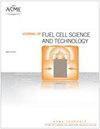Robotic Arm for Automated Assembly of Proton Exchange Membrane Fuel Cell Stacks
引用次数: 13
Abstract
We present an innovative, inexpensive end-effector, the robot workcell, and the fuel cell components used to demonstrate the automated assembly process of a proton exchange membrane fuel cell stack. The end-effector is capable of handling a variety of fuel cell components including membrane electrode assemblies, bipolar plates and gaskets using vacuum cups mounted on level compensators and connected to a miniature vacuum pump. The end-effector and the fuel cell components are designed with features that allow an accurate component alignment during the assembly process within a tolerance of 0.02 in. and avoiding component overlapping which represents a major cause of overboard gas leaks during the fuel cell operation. The accurate component alignment in the stack is achieved with electrically nonconductive alignment pins permanently mounted on one fuel cell endplate and positioning holes machined on the fuel cell components and on the end-effector. The alignment pins feature a conical tip which eases the engagement between them and the positioning holes. A passive compliance system consisting of two perpendicularly mounted miniature linear blocks and rails allow compensating for the robot's limitations in accuracy and repeatability.质子交换膜燃料电池堆自动装配机械臂
我们提出了一种创新的,廉价的末端执行器,机器人工作单元,以及用于演示质子交换膜燃料电池堆自动化组装过程的燃料电池组件。末端执行器能够处理各种燃料电池组件,包括膜电极组件,双极板和垫片,使用安装在液位补偿器上的真空杯并连接到微型真空泵。末端执行器和燃料电池组件的设计特点是允许在装配过程中精确的组件对准在0.02英寸的公差范围内。避免组件重叠,这是燃料电池运行过程中溢出气体泄漏的主要原因。通过永久安装在一个燃料电池终板上的导电对中销和在燃料电池组件和末端执行器上加工的定位孔,可以实现对堆中的精确组件对齐。所述对中销具有锥形尖端,可减轻它们与定位孔之间的啮合。由两个垂直安装的微型线性块和轨道组成的被动顺应系统可以补偿机器人在精度和可重复性方面的局限性。
本文章由计算机程序翻译,如有差异,请以英文原文为准。
求助全文
约1分钟内获得全文
求助全文
来源期刊
自引率
0.00%
发文量
0
审稿时长
6-12 weeks
期刊介绍:
The Journal of Fuel Cell Science and Technology publishes peer-reviewed archival scholarly articles, Research Papers, Technical Briefs, and feature articles on all aspects of the science, engineering, and manufacturing of fuel cells of all types. Specific areas of importance include, but are not limited to: development of constituent materials, joining, bonding, connecting, interface/interphase regions, and seals, cell design, processing and manufacturing, multi-scale modeling, combined and coupled behavior, aging, durability and damage tolerance, reliability, availability, stack design, processing and manufacturing, system design and manufacturing, power electronics, optimization and control, fuel cell applications, and fuels and infrastructure.

 求助内容:
求助内容: 应助结果提醒方式:
应助结果提醒方式:


